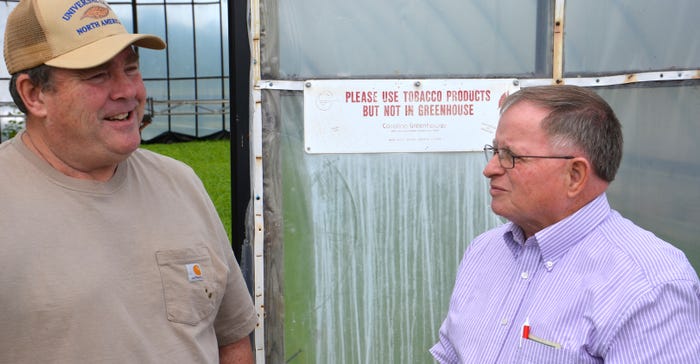
Dennis Gray, Kent, remembers his family raising a half acre of tobacco when he was a boy. They raised their own plants in a very labor-intensive system. How Gray raises tobacco today and the world he does it in are light-years removed from those earlier times.
“Dennis is a good example of someone who has adapted and is still raising the crop,” says Lonnie Mason, longtime Purdue University Extension educator in Jefferson County. “It’s different today, but there are still people who raise tobacco successfully.”
Here are seven ways the tobacco industry has changed in Indiana.
1. Only a handful of growers still grow tobacco in Jefferson County. “When I started in Extension, there were dozens of people raising tobacco, and most only raised a relatively small amount,” Mason says.
Gray estimates he and his two sons, who all also work off the farm, are part of only a handful of tobacco producers left in the county. “But we raise more acres,” he says. “We typically raise about 30 acres.”
2. Tobacco auction houses disappeared with the end of government subsidy programs. Madison, the county seat of Jefferson County, once had three tobacco auction houses. There were also several in Carrollton, Ky. Mason says all those are gone. There are a couple left in Kentucky, but none nearby.
3. Nearly all tobacco in Indiana today is grown under contract. “We have a contract with a company, and it sets our pricing depending upon quality,” Gray says. However, he adds that the contract specifies that the company doesn’t have to buy his tobacco. “Overall, the new contract system works pretty well, but there are no guarantees,” he explains.
4. There’s a sophisticated system for starting transplants today. It’s still a labor-intensive business, but technology helps him accomplish a lot more than his ancestors did in the past, Gray says.
“I raise enough plants for over 20 acres, and we buy the rest,” he explains. “We grow them on water beds in trays that hold over 200 plants each. To help keep them the right size, I mow tops off with a mower mounted on a frame that moves across the greenhouse.”
5. Growers can plant a tobacco crop much faster today. The wet spring in 2017 delayed transplanting. But Gray can plant up to 12 acres per day, using a four-row tobacco setter.
6. Varieties contain lower levels of nicotine. The varieties Gray raises today were developed to contain a lower level of nicotine. It involves breeding work that affects a certain gene within the plant. Some of this work is underway at the University of Kentucky. According to various specialists, there are differing viewpoints as to possible health benefits from reduced nicotine levels.
7. Tobacco is now grown for an international market. The burley tobacco Gray grows is typically exported overseas. “Even demand in some of those markets is declining, as other cultures promote healthier lifestyles,” Gray says. “We also face competition from growers in other countries. What helps us is that many foreign buyers like the quality of the burley grown here. It’s related to our humidity levels during curing in the fall, which affects quality of the final product.”
Check out the gallery below for a look at how Gray raises tobacco in this day and age.
About the Author(s)
You May Also Like




